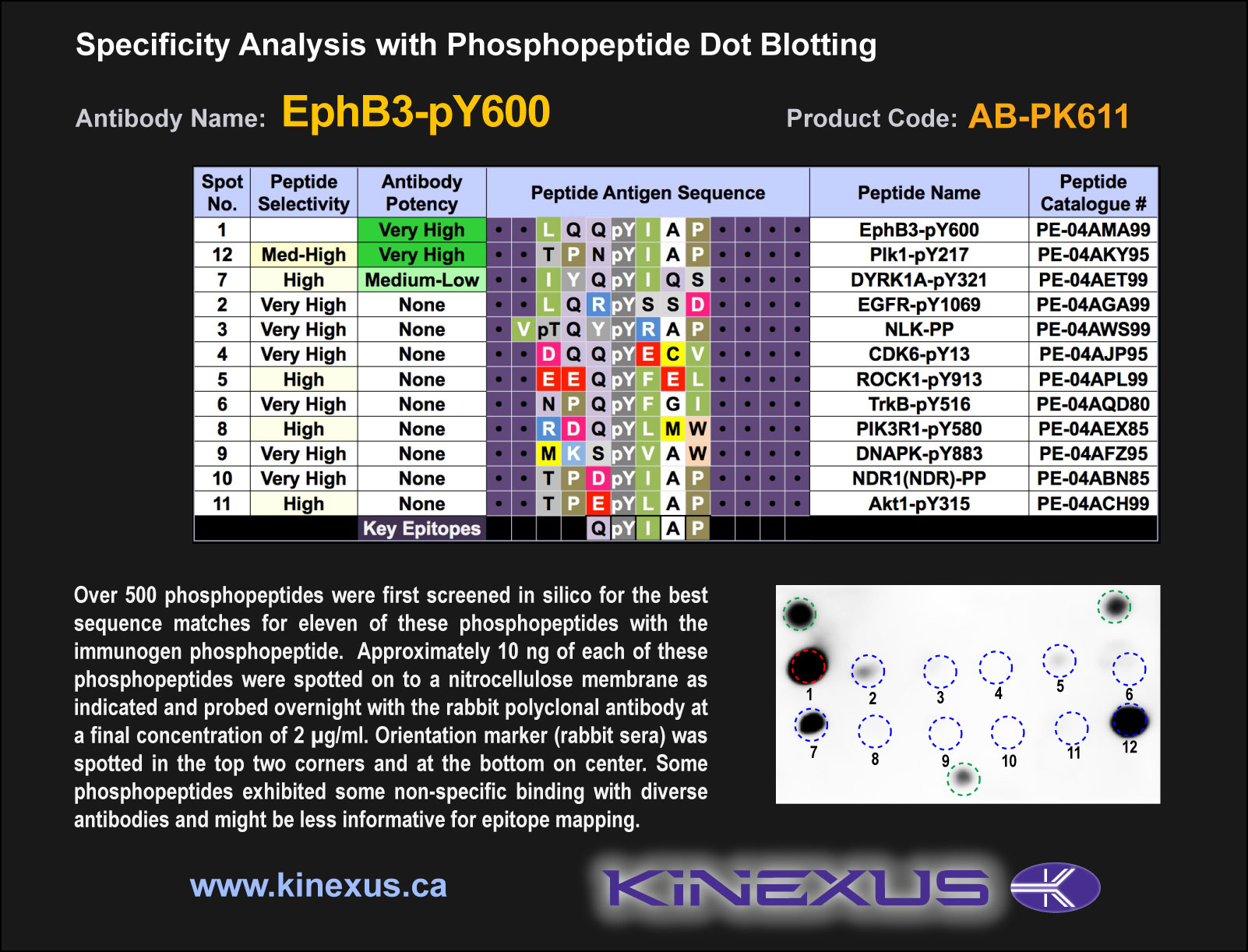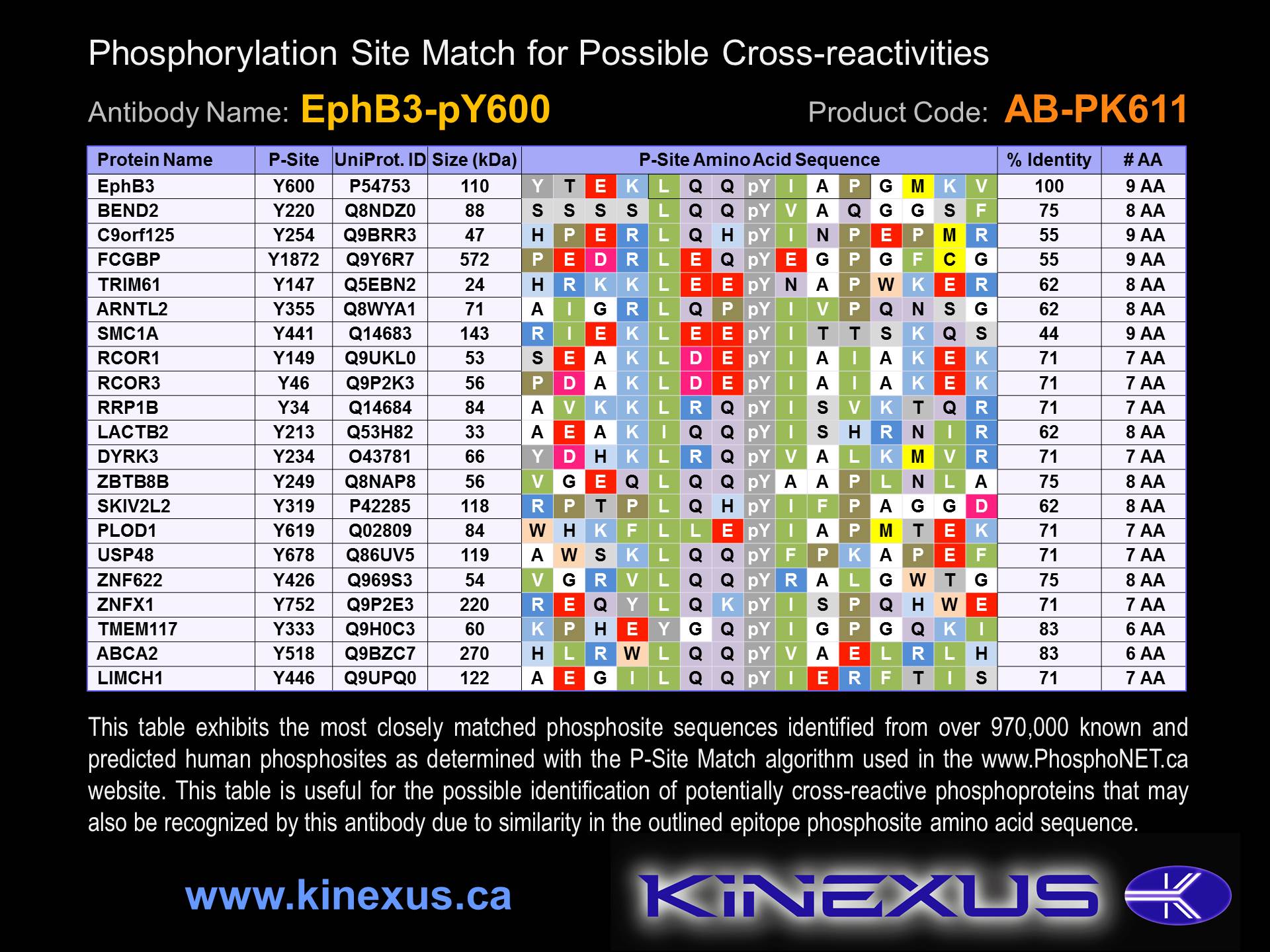Product Name: EphB3-pY600
Product Number: AB-PK611
| Size: | 25 µg | Price: | 89.00 | |
| $US |
Target Full Name: Ephrin type-B receptor 3 protein-tyrosine kinase
Target Alias: CEK10; Developmental kinase 5; Eph receptor B3; Ephrin type-B receptor 3; ETK2; HEK2; Kinase EphB3; MDK5; SEK4; Tyrosine-protein kinase receptor MDK-5; TYRO6; CCDS3268.1; ENSG00000182580
Product Type Specific: Protein kinase phosphosite-specific antibody
Antibody Code: PK611
Antibody Target Type: Phosphosite-specific
Antibody Phosphosite: Y600
Protein UniProt: P54753
Protein SigNET: P54753
Antibody Type: Polyclonal
Antibody Host Species: Rabbit
Target Alias: CEK10; Developmental kinase 5; Eph receptor B3; Ephrin type-B receptor 3; ETK2; HEK2; Kinase EphB3; MDK5; SEK4; Tyrosine-protein kinase receptor MDK-5; TYRO6; CCDS3268.1; ENSG00000182580
Product Type Specific: Protein kinase phosphosite-specific antibody
Antibody Code: PK611
Antibody Target Type: Phosphosite-specific
Antibody Phosphosite: Y600
Protein UniProt: P54753
Protein SigNET: P54753
Antibody Type: Polyclonal
Antibody Host Species: Rabbit
Antibody Immunogen Source: Human EphB3 sequence peptide Cat. No.: PE-04AMA99
Antibody Immunogen Sequence: LQQ(pY)IAP(bA)C
Antibody Immunogen Description: Corresponds to amino acid residues L597 to P603; In the EphA2_TM region between the transmembrane and kinase catalytic domains. This is the major in vivo phosphorylation site for EphB3.
Antibody Immunogen Sequence: LQQ(pY)IAP(bA)C
Antibody Immunogen Description: Corresponds to amino acid residues L597 to P603; In the EphA2_TM region between the transmembrane and kinase catalytic domains. This is the major in vivo phosphorylation site for EphB3.
Production Method: The immunizing peptide was produced by solid phase synthesis on a multipep peptide synthesizer and purified by reverse-phase hplc chromatography. Purity was assessed by analytical hplc and the amino acid sequence confirmed by mass spectrometry analysis. This peptide was coupled to KLH prior to immunization into rabbits. New Zealand White rabbits were subcutaneously injected with KLH-coupled immunizing peptide every 4 weeks for 4 months. The sera from these animals was applied onto an agarose column to which the immunogen peptide was thio-linked. Antibody was eluted from the column with 0.1 M glycine, pH 2.5. Subsequently, the antibody solution was neutralized to pH 7.0 with saturated Tris.This antibody was also subject to negative purification over phosphotyrosine-agarose.
Antibody Modification: Unconjugated. Contact KInexus if you are interest in having the antibody biotinylated or coupled with fluorescent dyes.
Antibody Modification: Unconjugated. Contact KInexus if you are interest in having the antibody biotinylated or coupled with fluorescent dyes.
Antibody Concentration: 1.0 mg/ml
Storage Buffer: Phosphate buffered saline pH 7.4, 0.05% Thimerasol
Storage Conditions: For long term storage, keep frozen at -40°C or lower. Stock solution can be kept at +4°C for more than 3 months. Avoid repeated freeze-thaw cycles.
Product Use: Western blotting | Antibody microarray
Antibody Dilution Recommended: 2 µg/ml for immunoblotting
Antibody Potency: Very strong immunoreactivity with immunogen peptide on dot blots.
Antibody Species Reactivity: Human
Antibody Positive Control: The observed molecular mass of the processed target protein on SDS-PAGE gels is reported to be around 105-115 kDa.
Storage Buffer: Phosphate buffered saline pH 7.4, 0.05% Thimerasol
Storage Conditions: For long term storage, keep frozen at -40°C or lower. Stock solution can be kept at +4°C for more than 3 months. Avoid repeated freeze-thaw cycles.
Product Use: Western blotting | Antibody microarray
Antibody Dilution Recommended: 2 µg/ml for immunoblotting
Antibody Potency: Very strong immunoreactivity with immunogen peptide on dot blots.
Antibody Species Reactivity: Human
Antibody Positive Control: The observed molecular mass of the processed target protein on SDS-PAGE gels is reported to be around 105-115 kDa.
Antibody Specificity: High-very high
Antibody Cross Reactivity: No significant cross-reactive proteins detected in A431, HeLa, MCF7 and HepG2 cells, except for a very strong ~40 kDa cross-reactive protein in MCF7 and HepG2 cells.
Related Product 1: EphB3-pY600 blocking peptide
Related Product 2: EphB1-pY594 phosphosite-specific antibody (Cat. No.: AB-PK609)
Related Product 3: EphB2-PCT pan-specific antibody (Cat. No.: AB-NK267-2)
Related Product 4: EphB2-PCT pan-specific antibody (Cat. No.: AB-NK267-2)
Related Product 5: EphB2-pY780 phosphosite-specific antibody (Cat. No.: AB-PK610)
Related Product 6: EphSubtide - EphB1 protein kinase substrate peptide
Antibody Cross Reactivity: No significant cross-reactive proteins detected in A431, HeLa, MCF7 and HepG2 cells, except for a very strong ~40 kDa cross-reactive protein in MCF7 and HepG2 cells.
Related Product 1: EphB3-pY600 blocking peptide
Related Product 2: EphB1-pY594 phosphosite-specific antibody (Cat. No.: AB-PK609)
Related Product 3: EphB2-PCT pan-specific antibody (Cat. No.: AB-NK267-2)
Related Product 4: EphB2-PCT pan-specific antibody (Cat. No.: AB-NK267-2)
Related Product 5: EphB2-pY780 phosphosite-specific antibody (Cat. No.: AB-PK610)
Related Product 6: EphSubtide - EphB1 protein kinase substrate peptide
Scientific Background: EphB3 is a member of the TK group of protein kinases in the Eph family. EphB3 is expressed during embryonic development in multiple regions of the central nervous system. In adult brain, EphB3 is expressed in the cerebellum, raphe pallidus, hippocampus, entorhinal cortex, and both motor and sensory cortices, and is moderate to highly expressed in most tested adult human tissues. Orthologues of EphB3 are highly conserved in vertebrates, including amphibians. EphB3 is activated by binding ephrin-B1, B2, or B3. Phosphorylation at Y614 induces interaction with Crk, Fyn, and RasGAP. EphB3 is involved in the maintenance of mature neuronal connections and/or re-arrangement of synaptic connections during late stages of development. EphB3 plays a role in the regulation of cell adhesion and migration, and the catalytic activity of EphB3 is required for inhibition of integrin-mediated cell adhesion. EphB3 appears to be an oncoprotein (OP). Over-expression of EphB3 has been observed in several cancer types, including colon cancer and lung cancer. Additionally, EphB3 over-expression was demonstrated in non-small cell lung cancer (NSCLC) and the expression level was highly correlated with pathological features, including tumour size, differentiation, and metastasis. over-expression of EphB3 in NSCLC cell lines enhanced cell growth and migration and promoted tumourigenesis. By contrast, EphB3 knockout in NSCLC lines reduced cell proliferation and migration and suppressed tumour growth. EphB3 has been linked with the development of lung neuroendocrine carcinomas and lung small cell carcinomas (LSCC).
Figure 1. Epitope mapping of EphB3-pY600 antibody with similar phosphopeptides on dot blots.
Figure 2. Identification of phosphosites related to EphB3-pY600.
© Kinexus Bioinformatics Corporation 2017



